Ar+ Ion Irradiation Response of LPBF AlSi10Mg Alloy in As-Built and KOBO-Processed Conditions
Abstract
:1. Introduction
2. Methodology
- punch speed 0.2 mm/s,
- the frequency of die oscillations was 5 Hz,
- the oscillation angle was ±8°.
- extrusion was carried out in one step with an extrusion ratio λ = 225 (604).
3. Results
3.1. Microstructure of Samples before Irradiation
3.2. Microstructure Evolution after Ar+ Irradiation
4. Discussion
5. Conclusions
- The as-built sample exhibited a microstructure composed of Al/Si cells approximately 500 nm in size, with an average grain size of about 3.3 μm. KOBO processing significantly modified the grain microstructure and Si phase morphology. The grain size was reduced to about 0.8 μm, and the cellular eutectic Si network was disrupted.
- After KOBO thermomechanical treatment, the frequency of the low-ΣCSL boundaries in the LPBF AlSi10Mg alloy increased from about 35% to 43%. The low-ΣCSL boundaries were randomly distributed within the alloy microstructure.
- Ar+ irradiation at a fluence of 5 × 1017 cm−2 caused the formation of a thick, porous layer with partial amorphization of phases in both samples. The as-built sample, with larger pores, showed lower radiation resistance. Additionally, irradiation-induced severe grain refinement beneath the porous layer and produced typical defects such as Ar bubbles, dislocations, and stacking faults in both samples.
Author Contributions
Funding
Data Availability Statement
Acknowledgments
Conflicts of Interest
References
- Cabet, C.; Dalle, F.; Gaganidze, E.; Henry, J.; Tanigawa, H. Ferritic-martensitic steels for fission and fusion applications. J. Nucl. Mater. 2019, 523, 510–537. [Google Scholar] [CrossRef]
- Mourad, M.M.; Saudi, H.A.; Eissa, M.M.; Hassaan, M.Y.; Abdel-Latif, M.A. Modified austenitic stainless-steel alloys for sheilding nuclear reactors. Progress Nucl. Energy 2021, 142, 104009. [Google Scholar] [CrossRef]
- Brito, D.R.; Sánchez, E.A.; Tolley, A. Characterization of He Bubbles in Irradiated Aluminium with High Resolution Transmission Electron Microscopy and Electron Energy Loss Spectroscopy. Microsc. Microanal. 2020, 26, 25–26. [Google Scholar] [CrossRef]
- Wang, J.; Liu, S.; Xu, B.; Zhang, J.; Sun, M.; Li, D. Research progress on preparation technology of oxide dispersion strengthened steel for nuclear energy. Int. J. Extrem. Manuf. 2021, 3, 032001. [Google Scholar] [CrossRef]
- Gushchina, N.V.; Makhin’ko, F.F.; Ovchinnikov, V.V.; Kataeva, N.V.; Voronin, V.I.; Bobrovskii, V.I.; Sagaradze, V.V. Effect of Medium-Energy Ar+ Ion Irradiation on the Structure of Austenitic Chromium–Nickel Steel. Phys. Met. Metallogr. 2021, 122, 307–313. [Google Scholar] [CrossRef]
- L’haridon-Quaireau, S. Study of Corrosion Processes and Irradiation Effect on Aluminium Alloys Used for Research Reactors Material Structure; Universite de Paris-Saclay: Gif-sur-Yvette, France, 2020. [Google Scholar]
- Snopiński, P.; Appiah, A.N.; Hilšer, O.; Kotoul, M. Investigation of Microstructure and Mechanical Properties of SLM-Fabricated AlSi10Mg Alloy Post-Processed Using Equal Channel Angular Pressing (ECAP). Materials 2022, 15, 7940. [Google Scholar] [CrossRef]
- Snopiński, P.; Król, M.; Tański, T.; Pakuła, D.; Kříž, A. Effect of initial microstructure on hot deformation behavior of AlMg5Si2Mn alloy. Mater. Charact. 2021, 177, 111167. [Google Scholar] [CrossRef]
- Milagre, M.X.; Donatus, U.; Silva, R.M.P.; Betancor-Abreu, A.M.; Ramirez, O.M.P.; Machado, C.S.C.; Araujo, J.V.S.; Souto, R.M.; Costa, I. Galvanic coupling effects on the corrosion behavior of the 6061 aluminum alloy used in research nuclear reactors. J. Nucl. Mater. 2020, 541, 152440. [Google Scholar] [CrossRef]
- Piatti, G.; Fiorini, P.; Schiller, P. High purity aluminium alloys for experimental fusion reactors. Nucl. Eng. Des. Fusion 1984, 1, 137–158. [Google Scholar] [CrossRef]
- Was, G.S.; Bruemmer, S.M. Effects of irradiation on intergranular stress corrosion cracking. J. Nucl. Mater. 1994, 216, 326–347. [Google Scholar] [CrossRef]
- Yan, Z.; Zhou, W.; Zheng, J.; Wang, G.; Liu, X.; Liu, X.; Wang, S.; Gao, C.; Tian, J.; Wang, H.; et al. Investigations of microstructure and tensile properties of neutron irradiated 6061 aluminum alloys. Mater. Sci. Eng. A 2024, 890, 145913. [Google Scholar] [CrossRef]
- Xiao, X.; Terentyev, D.; Chu, H.; Duan, H. Theoretical models for irradiation hardening and embrittlement in nuclear structural materials: A review and perspective. Acta Mech. Sin. 2020, 36, 397–411. [Google Scholar] [CrossRef]
- Zhang, X.; Hattar, K.; Chen, Y.; Shao, L.; Li, J.; Sun, C.; Yu, K.; Li, N.; Taheri, M.L.; Wang, H.; et al. Radiation damage in nanostructured materials. Prog. Mater. Sci. 2018, 96, 217–321. [Google Scholar] [CrossRef]
- Liu, Z.; Feng, Z.; Wang, H.; Zhang, Y.; Chen, Z.; Meng, F.; Zhang, J. Atomic-scale investigation of the irradiation-resistant effect of symmetric tilt grain boundaries of Fe-Ni-Cr alloy. arXiv 2021, arXiv:2102.06907. [Google Scholar] [CrossRef]
- Snopiński, P. Effects of KoBo-Processing and Subsequent Annealing Treatment on Grain Boundary Network and Texture Development in Laser Powder Bed Fusion (LPBF) AlSi10Mg Alloy. Symmetry 2024, 16, 122. [Google Scholar] [CrossRef]
- Snopiński, P.; Matus, K. Characterisation of Microstructure and Special Grain Boundaries in LPBF AlSi10Mg Alloy Subjected to the KoBo Extrusion Process. Symmetry 2023, 15, 1634. [Google Scholar] [CrossRef]
- Chen, Y.; Li, J.; Yu, K.Y.; Wang, H.; Kirk, M.A.; Li, M.; Zhang, X. In situ studies on radiation tolerance of nanotwinned Cu. Acta Mater. 2016, 111, 148–156. [Google Scholar] [CrossRef]
- Li, J.; Chen, Y.; Wang, H.; Zhang, X. In Situ Studies on Twin-Thickness-Dependent Distribution of Defect Clusters in Heavy Ion-Irradiated Nanotwinned Ag. Metall. Mater. Trans. A 2017, 48, 1466–1473. [Google Scholar] [CrossRef]
- Du, J.; Wu, Z.; Fu, E.; Liang, Y.; Wang, X.; Wang, P.; Yu, K.; Ding, X.; Li, M.; Kirk, M. Detwinning through migration of twin boundaries in nanotwinned Cu films under in situ ion irradiation. Sci. Technol. Adv. Mater. 2018, 19, 212–220. [Google Scholar] [CrossRef]
- Yan, X.; Wang, F.; Deng, L.; Zhang, C.; Lu, Y.; Nastasi, M.; Kirk, M.A.; Li, M.; Cui, B. Effect of Laser Shock Peening on the Microstructures and Properties of Oxide-Dispersion-Strengthened Austenitic Steels. Adv. Eng. Mater. 2017, 20, 1700641. [Google Scholar] [CrossRef]
- Kan, W.H.; Nadot, Y.; Foley, M.; Ridosz, L.; Proust, G.; Cairney, J.M. Factors that affect the properties of additively-manufactured AlSi10Mg: Porosity versus microstructure. Addit. Manuf. 2019, 29, 100805. [Google Scholar] [CrossRef]
- Huang, S.; Guo, S.; Zhou, B.; Zhang, G.; Zhang, X. Microstructure and properties of AlSi7Mg alloy fabricated by selective laser melting. China Foundry 2021, 18, 416–423. [Google Scholar] [CrossRef]
- Landau, P.; Saffar, T.; Orion, I.; Girshevitz, O.; Tiferet, E. Helium bubble formation in additive manufactured L-PBF AlSi10Mg. J. Nucl. Mater. 2023, 582, 154473. [Google Scholar] [CrossRef]
- Ungarish, Z.; Aizenshtein, M.; Woller, K.; Short, M.P.; Hayun, S. The effect of thermal history on the additively manufactured AlSi10Mg alloy response to ion irradiation. J. Nucl. Mater. 2024, 588, 154788. [Google Scholar] [CrossRef]
- Chen, W.-Y.; Chen, Y.; Baldo, P.; Hlavenka, J.; Harbaruk, D. In-Situ and Ex-Situ Characterization of Ion-Irradiated AM Materials; Argonne National Laboratory: Argonne, IL, USA, 2023. [Google Scholar] [CrossRef]
- Liu, H.; Min, S.; Jiang, M.; Qiu, S.; Kuang, W.; Chen, Z.; Hou, J. Corrosion performance of He+ ion irradiated 304 L stainless steel made by laser powder bed fusion in simulated PWR water. Corros. Sci. 2022, 206, 110545. [Google Scholar] [CrossRef]
- Biswas, P.; Ma, J. Development of crystallographic misorientation in laser powder bed fusion 316L stainless steel. Addit. Manuf. 2024, 80, 103951. [Google Scholar] [CrossRef]
- Kong, D.; Dong, C.; Wei, S.; Ni, X.; Zhang, L.; Li, R.; Wang, L.; Man, C.; Li, X. About metastable cellular structure in additively manufactured austenitic stainless steels. Addit. Manuf. 2021, 38, 101804. [Google Scholar] [CrossRef]
- Prashanth, K.G.; Eckert, J. Formation of metastable cellular microstructures in selective laser melted alloys. J. Alloys Compd. 2017, 707, 27–34. [Google Scholar] [CrossRef]
- Evers, L.P.; Brekelmans, W.A.M.; Geers, M.G.D. Non-local crystal plasticity model with intrinsic SSD and GND effects. J. Mech. Phys. Solids 2004, 52, 2379–2401. [Google Scholar] [CrossRef]
- Lu, C.; Jin, K.; Béland, L.K.; Zhang, F.; Yang, T.; Qiao, L.; Zhang, Y.; Bei, H.; Christen, H.M.; Stoller, R.E.; et al. Direct Observation of Defect Range and Evolution in Ion-Irradiated Single Crystalline Ni and Ni Binary Alloys. Sci. Rep. 2016, 6, 19994. [Google Scholar] [CrossRef] [PubMed]
- Korbel, A.; Bochniak, W.; Borowski, J.; Błaż, L.; Ostachowski, P.; Łagoda, M. Anomalies in precipitation hardening process of 7075 aluminum alloy extruded by KOBO method. J. Mater. Process Technol. 2015, 216, 160–168. [Google Scholar] [CrossRef]
- Korbel, A.; Błaż, L.; Bochniak, W.; Pawlyta, M.; Ostachowski, P.; Łagoda, M. Nano-Dimensional Elements in the Structure of Zinc Subjected to KOBO Extrusion. Metallogr. Microstruct. Anal. 2023, 12, 427–432. [Google Scholar] [CrossRef]
- Bochniak, W.; Marszowski, K.; Korbel, A. Theoretical and practical aspects of the production of thin-walled tubes by the KOBO method. J. Mater. Process Technol. 2005, 169, 44–53. [Google Scholar] [CrossRef]
- Betlej, I.; Barlak, M.; Wilkowski, J.; Werner, Z.; Zagórski, J.; Lipska, K.; Boruszewski, P. Wettability of the surface of bacterial cellulose film modified with the ion implantation. Ann. WULS For. Wood Technol. 2022, 118, 15–21. [Google Scholar] [CrossRef]
- Brandon, D.G. The structure of high-angle grain boundaries. Acta Metall. 1966, 14, 1479–1484. [Google Scholar] [CrossRef]
- Alghamdi, F.; Song, X.; Hadadzadeh, A.; Shalchi-Amirkhiz, B.; Mohammadi, M.; Haghshenas, M. Post heat treatment of additive manufactured AlSi10Mg: On silicon morphology, texture and small-scale properties. Mater. Sci. Eng. A 2020, 783, 139296. [Google Scholar] [CrossRef]
- Tradowsky, U.; White, J.; Ward, R.M.; Read, N.; Reimers, W.; Attallah, M.M. Selective laser melting of AlSi10Mg: Influence of post-processing on the microstructural and tensile properties development. Mater. Des. 2016, 105, 212–222. [Google Scholar] [CrossRef]
- Cho, K.T.; Yoo, S.; Lim, K.M.; Kim, H.S.; Lee, W.B. Effect of Si content on surface hardening of Al–Si alloy by shot peening treatment. J. Alloys Compd. 2011, 509, S265–S270. [Google Scholar] [CrossRef]
- Xu, C.; Tian, X.; Jiang, W.; Wang, Q.; Fan, H. The sink efficiency of symmetric tilt grain boundary under displacement cascade in zirconium. J. Nucl. Mater. 2024, 591, 154911. [Google Scholar] [CrossRef]
- Sun, C.; Zheng, S.; Wei, C.C.; Wu, Y.; Shao, L.; Yang, Y.; Hartwig, K.T.; Maloy, S.A.; Zinkle, S.J.; Allen, T.R.; et al. Superior radiation-resistant nanoengineered austenitic 304L stainless steel for applications in extreme radiation environments. Sci. Rep. 2015, 5, 7801. [Google Scholar] [CrossRef]
- LaGrange, T.; Arakawa, K.; Yasuda, H.; Kumar, M. Preferential void formation at crystallographically ordered grain boundaries in nanotwinned copper thin films. Acta Mater. 2015, 96, 284–291. [Google Scholar] [CrossRef]
- Jin, M.; Cao, P.; Short, M.P. Achieving exceptional radiation tolerance with crystalline-amorphous nanocrystalline structures. Acta Mater. 2020, 186, 587–596. [Google Scholar] [CrossRef]
- Zhou, D.; Zhang, X.; Tehranchi, A.; Hou, J.; Lu, W.; Hickel, T.; Ponge, D.; Raabe, D.; Zhang, D. Stacking faults in a mechanically strong Al(Mg)–Al3Mg2 composite. Compos. B Eng. 2022, 245, 110211. [Google Scholar] [CrossRef]
- Liao, X.Z.; Srinivasan, S.G.; Zhao, Y.H.; Baskes, M.I.; Zhu, Y.T.; Zhou, F.; Lavernia, E.J.; Xu, H.F. Formation mechanism of wide stacking faults in nanocrystalline Al. Appl. Phys. Lett. 2004, 84, 3564–3566. [Google Scholar] [CrossRef]
- Huang, L.; Chen, Z.Q.; Liu, W.B.; Huang, P.; Meng, X.K.; Xu, K.W.; Wang, F.; Lu, T. Enhanced irradiation resistance of amorphous alloys by introducing amorphous/amorphous interfaces. Intermetallics 2019, 107, 39–46. [Google Scholar] [CrossRef]
- Su, Q.; Price, L.; Shao, L.; Nastasi, M. High temperature radiation responses of amorphous SiOC/crystalline Fe nanocomposite. J. Nucl. Mater. 2016, 479, 411–417. [Google Scholar] [CrossRef]
- Jiang, M.; Liu, H.; Qiu, S.; Min, S.; Gu, Y.; Kuang, W.; Hou, J. Irradiation damage and corrosion performance of proton irradiated 304 L stainless steel fabricated by laser-powder bed fusion. Mater. Charact. 2023, 202, 113023. [Google Scholar] [CrossRef]
- Uberuaga, B.P.; Choudhury, S.; Caro, A. Ideal sinks are not always ideal: Radiation damage accumulation in nanocomposites. J. Nucl. Mater. 2015, 462, 402–408. [Google Scholar] [CrossRef]
- Odette, G.R.; Alinger, M.J.; Wirth, B.D. Recent Developments in Irradiation-Resistant Steels. Annu. Rev. Mater. Res. 2008, 38, 471–503. [Google Scholar] [CrossRef]
- Demkowicz, M.J.; Anderoglu, O.; Zhang, X.; Misra, A. The influence of ∑3 twin boundaries on the formation of radiation-induced defect clusters in nanotwinned Cu. J. Mater. Res. 2011, 26, 1666–1675. [Google Scholar] [CrossRef]
- Han, W.Z.; Demkowicz, M.J.; Fu, E.G.; Wang, Y.Q.; Misra, A. Effect of grain boundary character on sink efficiency. Acta Mater. 2012, 60, 6341–6351. [Google Scholar] [CrossRef]


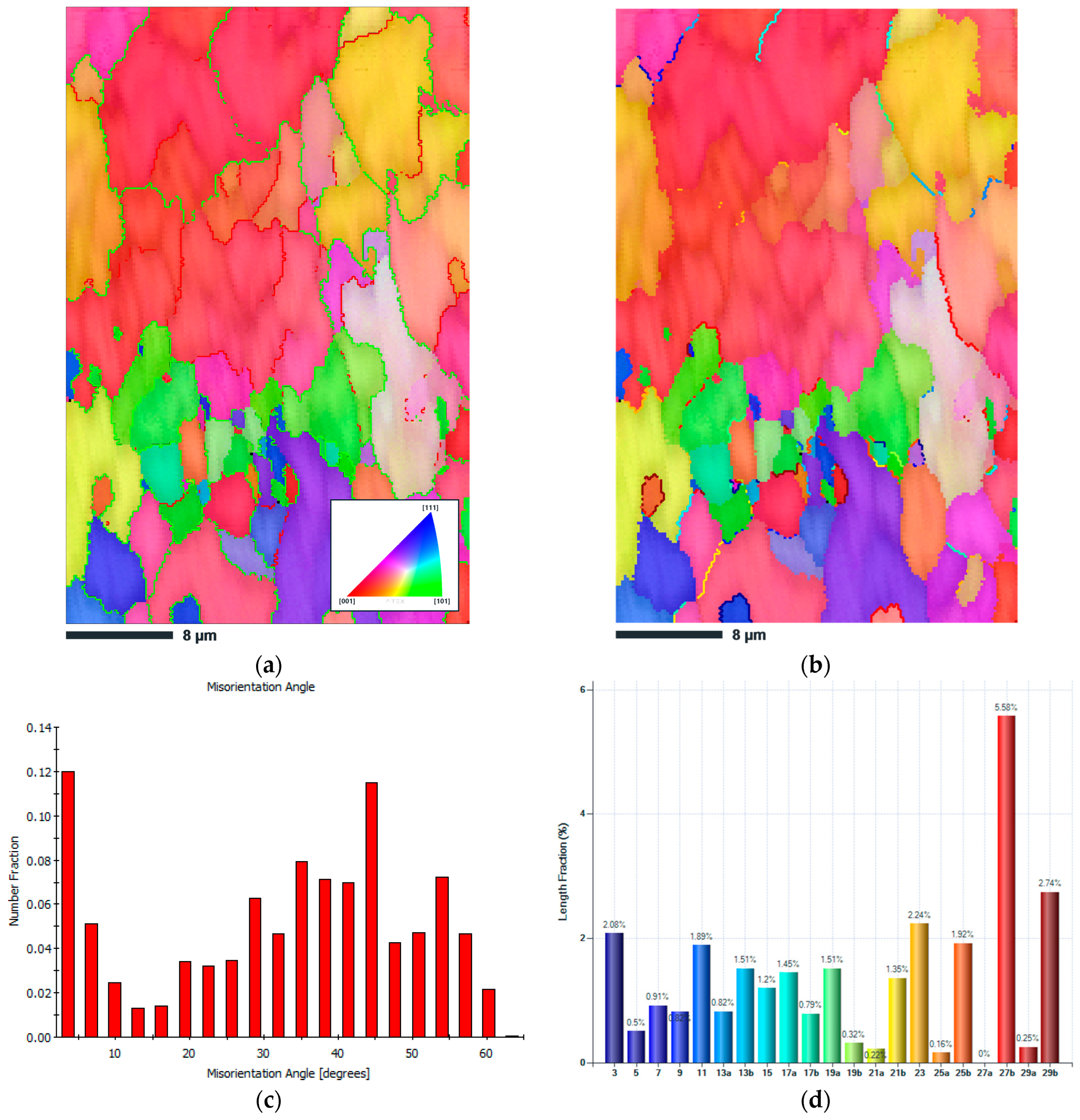
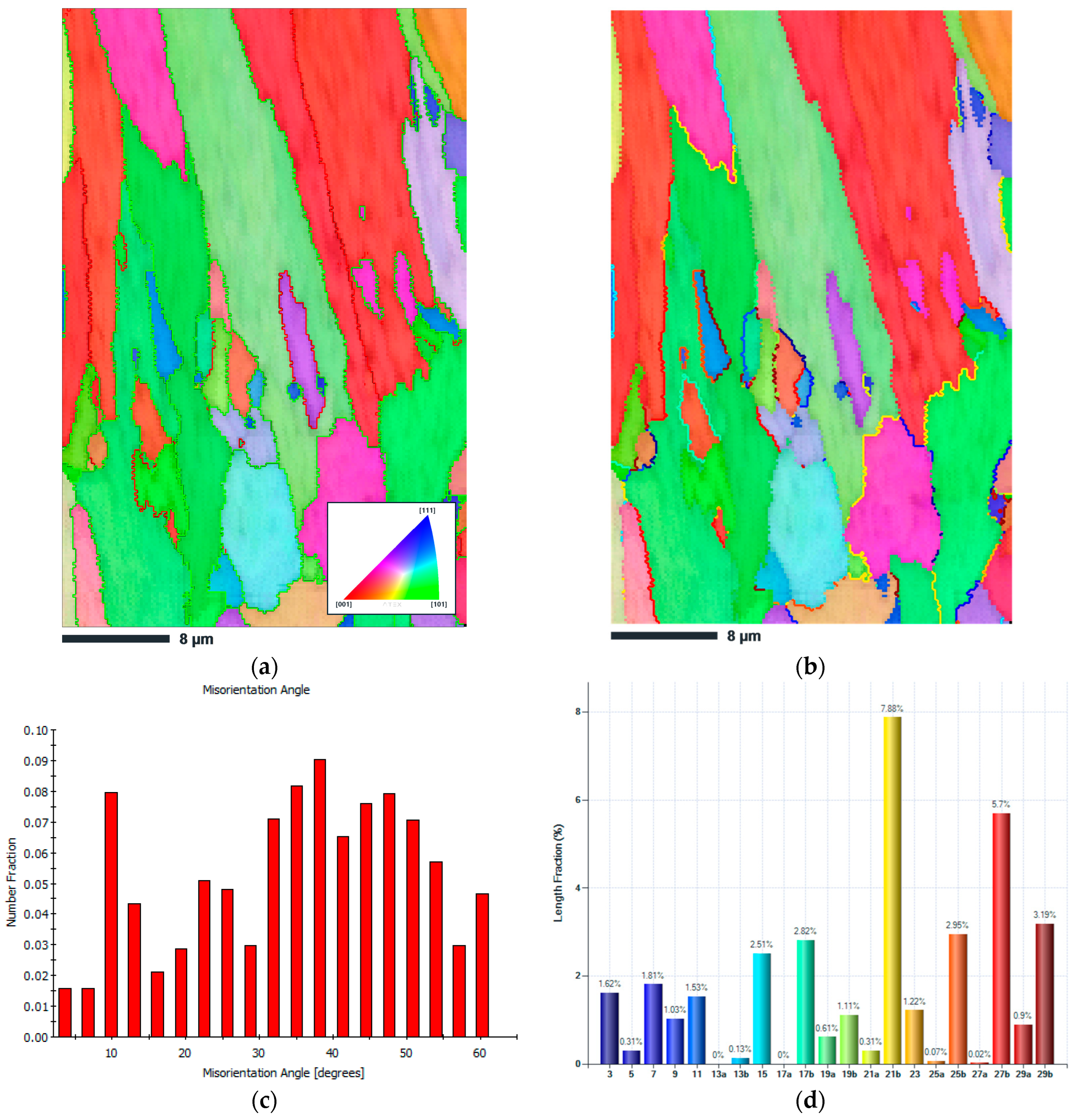
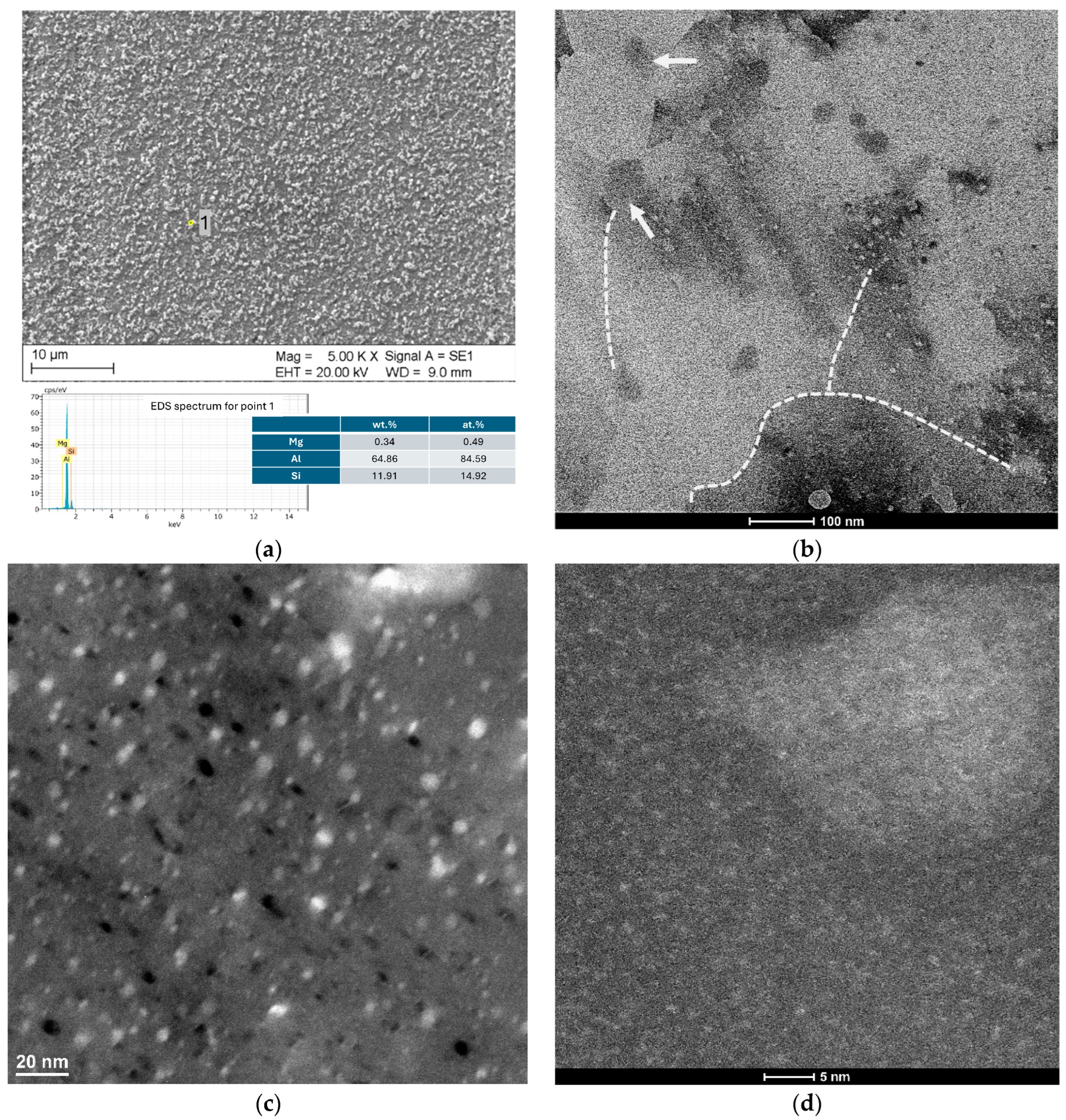
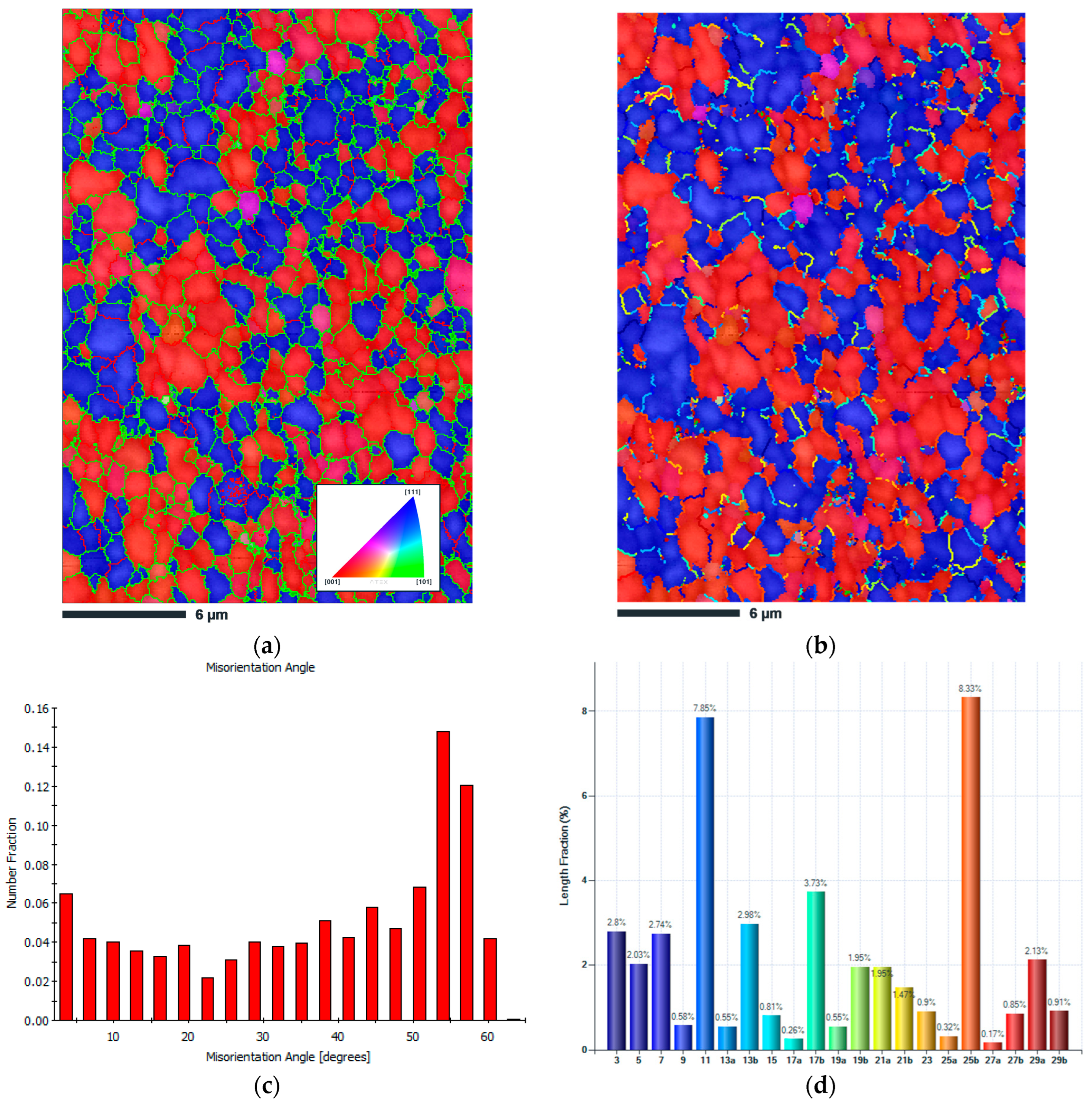
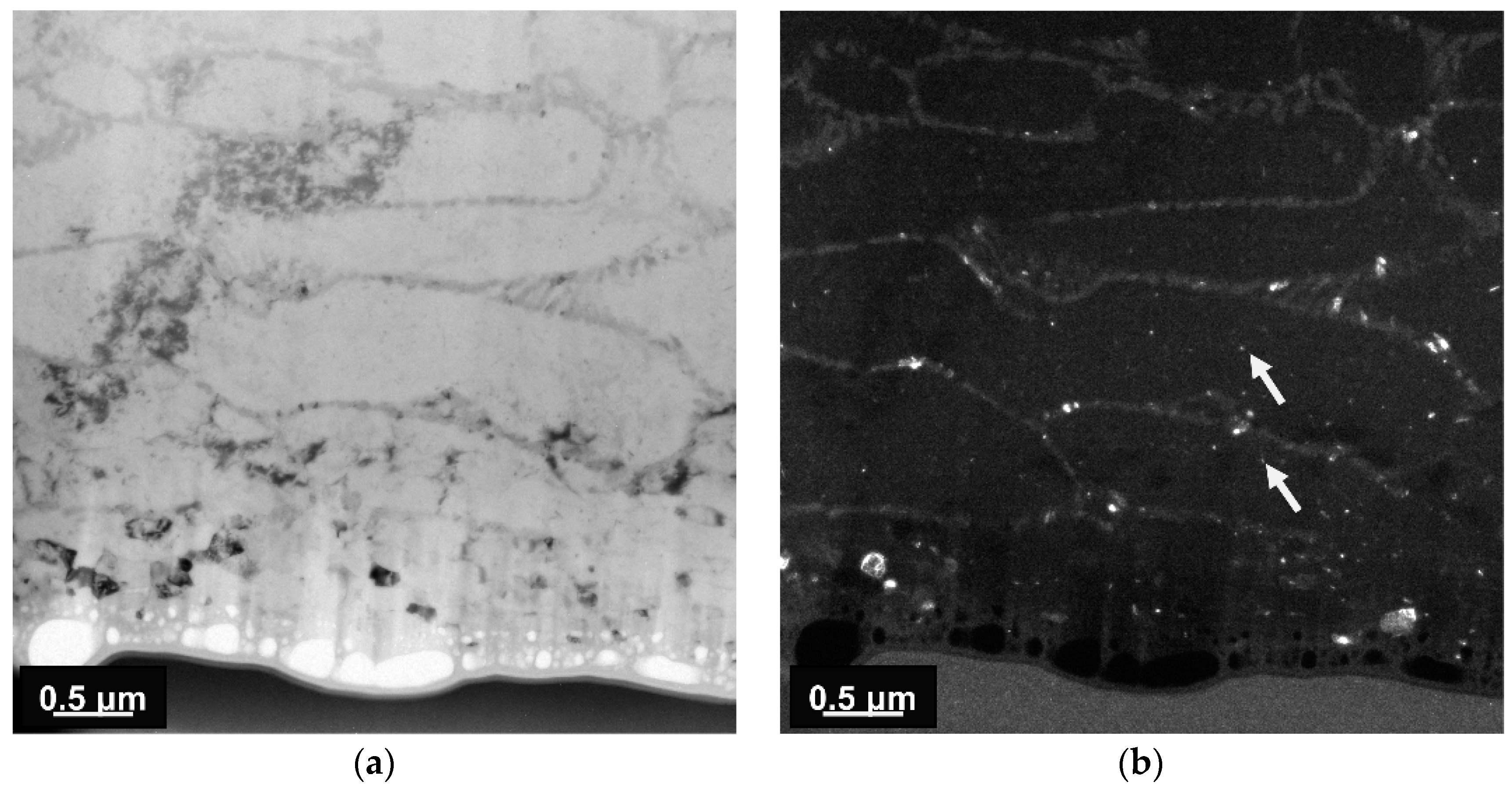
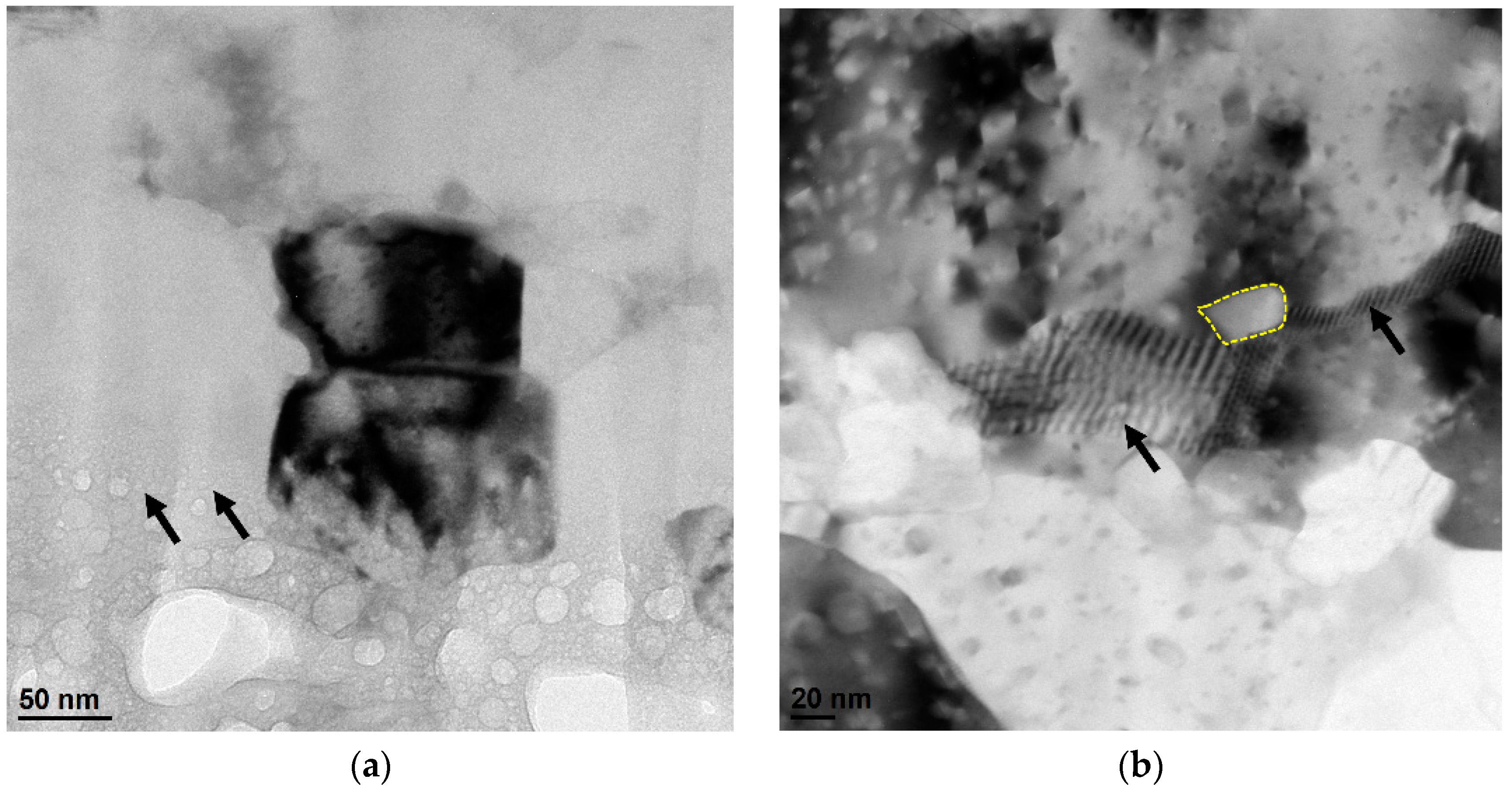
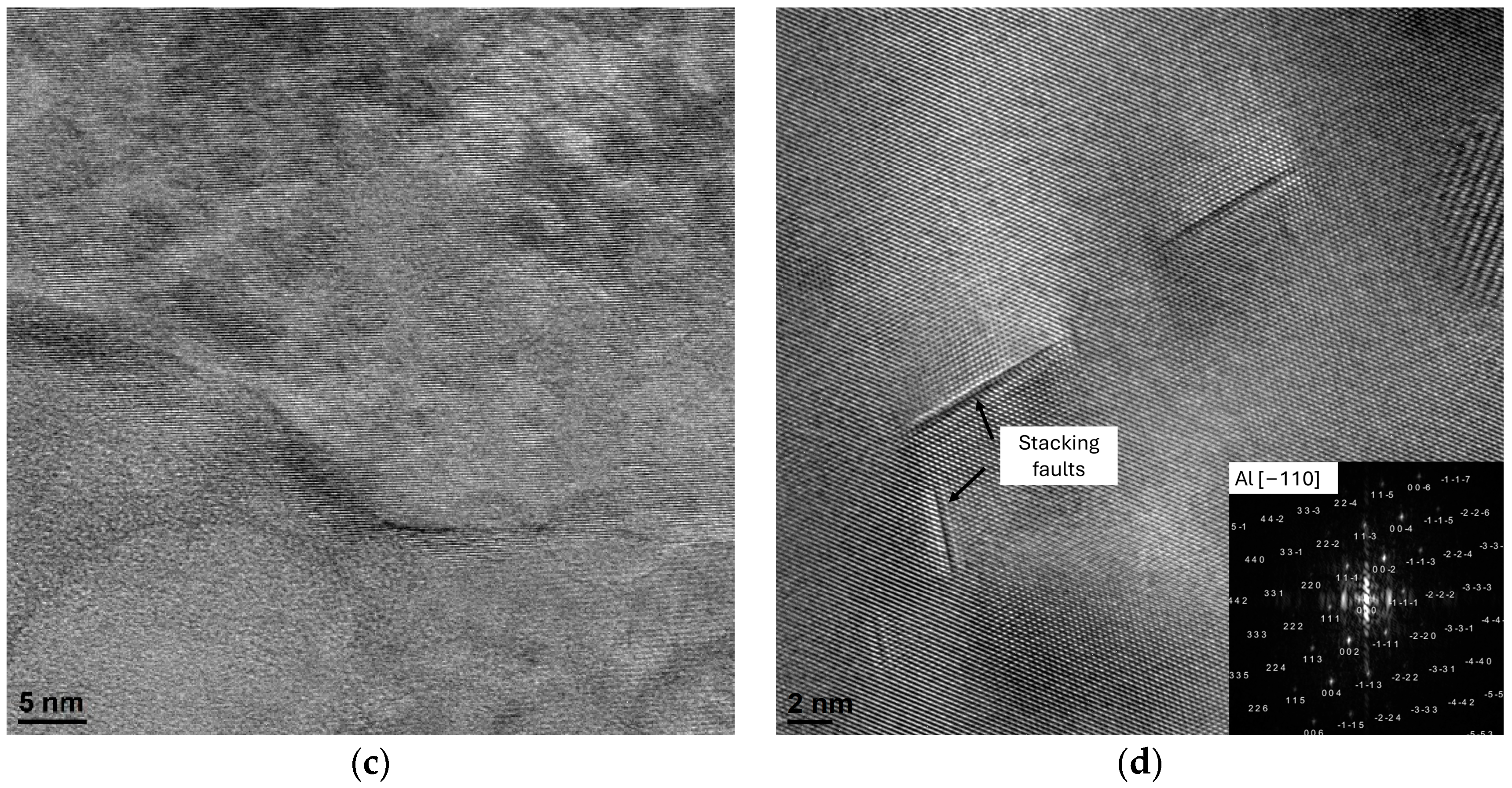
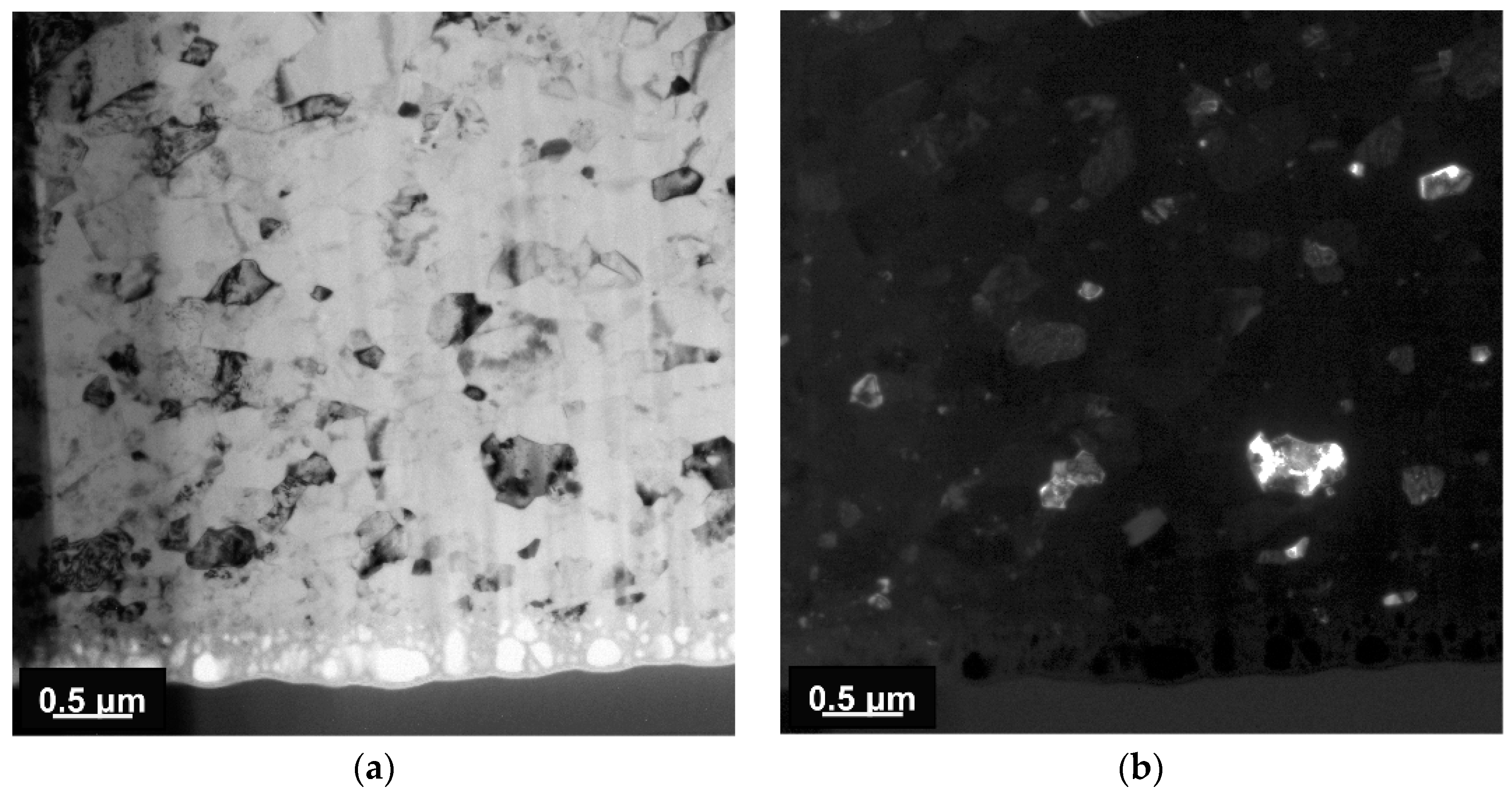

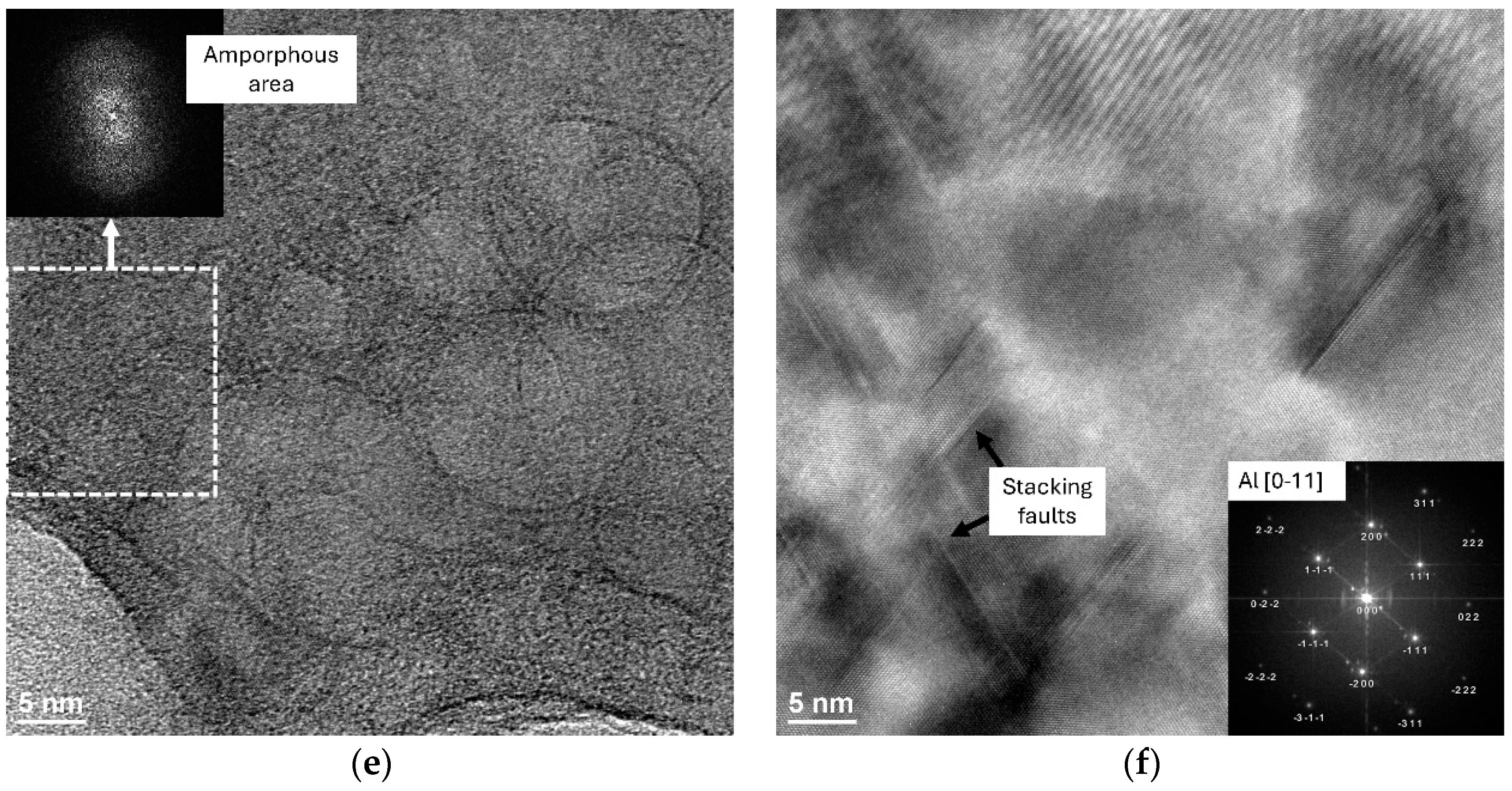
Disclaimer/Publisher’s Note: The statements, opinions and data contained in all publications are solely those of the individual author(s) and contributor(s) and not of MDPI and/or the editor(s). MDPI and/or the editor(s) disclaim responsibility for any injury to people or property resulting from any ideas, methods, instructions or products referred to in the content. |
© 2024 by the authors. Licensee MDPI, Basel, Switzerland. This article is an open access article distributed under the terms and conditions of the Creative Commons Attribution (CC BY) license (https://creativecommons.org/licenses/by/4.0/).
Share and Cite
Snopiński, P.; Barlak, M.; Nowakowska-Langier, K. Ar+ Ion Irradiation Response of LPBF AlSi10Mg Alloy in As-Built and KOBO-Processed Conditions. Symmetry 2024, 16, 1158. https://doi.org/10.3390/sym16091158
Snopiński P, Barlak M, Nowakowska-Langier K. Ar+ Ion Irradiation Response of LPBF AlSi10Mg Alloy in As-Built and KOBO-Processed Conditions. Symmetry. 2024; 16(9):1158. https://doi.org/10.3390/sym16091158
Chicago/Turabian StyleSnopiński, Przemysław, Marek Barlak, and Katarzyna Nowakowska-Langier. 2024. "Ar+ Ion Irradiation Response of LPBF AlSi10Mg Alloy in As-Built and KOBO-Processed Conditions" Symmetry 16, no. 9: 1158. https://doi.org/10.3390/sym16091158







